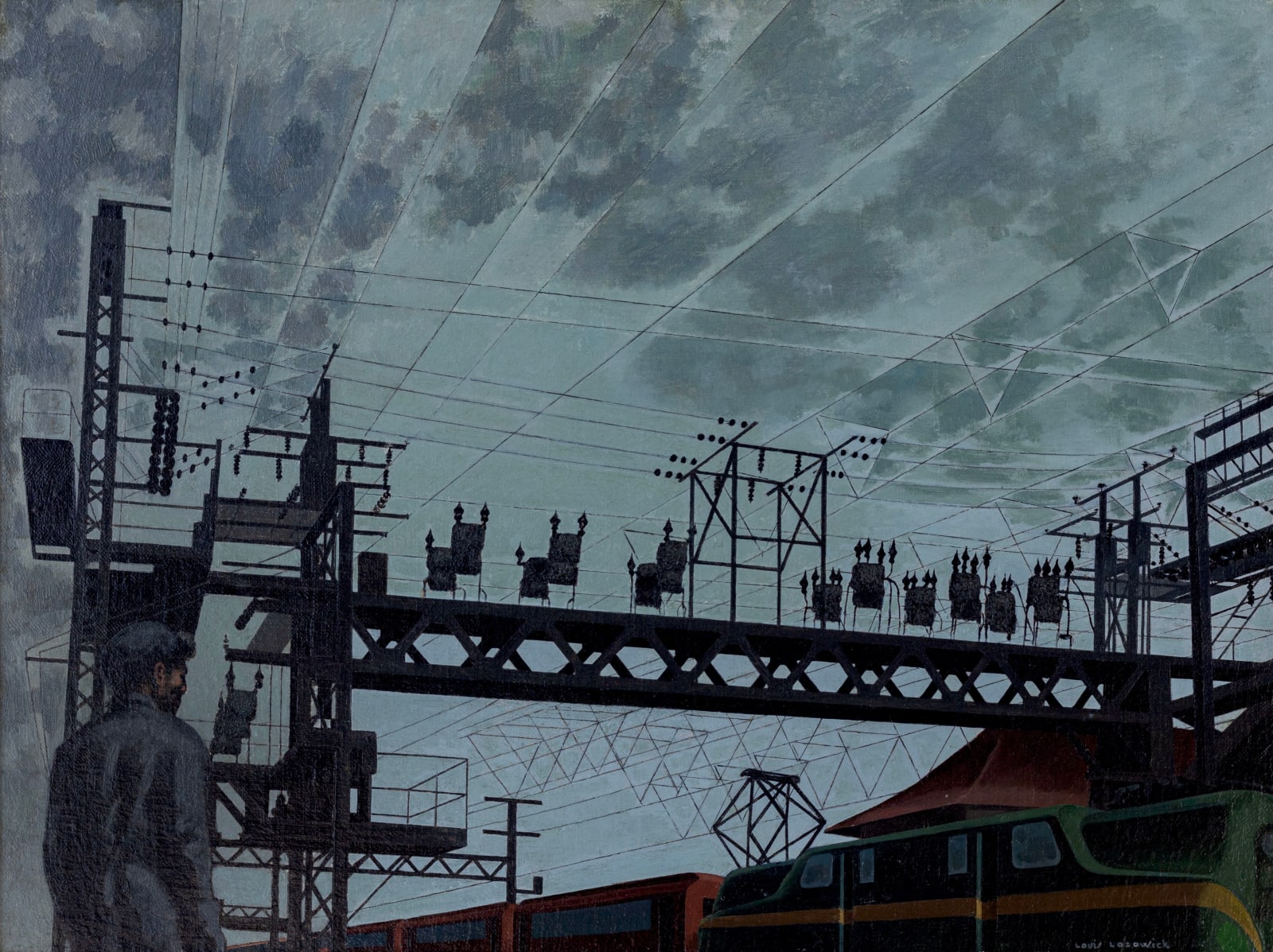Louis Lozowick
45.7 x 61 cm
During the 1920s, Louis Lozowick was the consummate Machine Age artist. His primary subject matter, American industrial architecture and modern technology, and his style, marked by pure, geometric forms, taut edges, and strong flat color, embodied the utopian belief in the machine as both a transformative cultural force and a rich source for the artist in America.
Born in Ukraine, Lozowick came to the United States in 1906 and studied at the National Academy of Design and Ohio State University. He joined in the army in 1918, and upon being discharged, he traveled widely in America and Europe. In 1920, he settled in Berlin, where he became part of the European avant-garde. He began making lithographs, which became his signature medium, and produced a group of dynamic abstract portraits of American cities that defined each city by its most prominent industry: Pittsburgh by its steel mills, Minneapolis by its grain silos, and so on. Lozowick returned to the U.S. in 1924. His crisp style and preference for industrial themes dovetailed with the innovative style now known as Precisionism just then coming to the forefront of American art. In 1927 he helped organize the landmark Machine Age Exposition, and his catalogue essay, “The Americanization of Art,” became a manifesto for the movement. There he asserted that the geometric forms of industrial design were the inspiration for “a solid plastic structure of great intricacy and subtlety. . . . The true artist will . . . objectify the dominant experience of our epoch in plastic terms that possess value for more than this epoch alone.” [1]
For the next several years, Lozowick’s art reflected that vision. His 1929 lithograph, High Voltage—Cos Cob (Smithsonian American Art Museum), pays homage to the electric power plant in Cos Cob, Connecticut, a key facility in the electrification of the railroad. Lozowick precisely describes but also celebrates this transformative technology. The grainy black and white of his medium evokes the gritty power of industry. The electric wires overhead form elegant metallic filigrees. The tower at left is rendered as a graphic pattern of geometric shapes and voids “of great intricacy and subtlety.” The viewer is positioned to gaze upward, in awe of American industrial triumph.
By the end of the decade, however, Lozowick’s belief in American technology and art’s role in promoting it had waned. The stock market crash and subsequent Depression cast technological advancement in a less positive light. Lozowick’s work became more descriptive, less abstract. Figures occur more frequently. Sometimes (for example, Above the City, 1932, lithograph), they are portrayed heroically. But elsewhere, they seem diminished by industrial power.
High Voltage—Cos Cob, the oil painting Lozowick made after the lithograph, reflects his growing disillusionment with technology and his commitment to a new kind of social change. The black-and-white palette of the lithograph—a palette of crisp efficiency and mechanical purity—becomes much more somber in the oil. The day is overcast and gray tones predominate, with muted brick red articulating the trains and buildings. Geometric shapes are still prominent, but the soaring lines of the wires and tower have become somewhat ominous, their formal perfection almost a rebuke to the lumpen figure at left. He gazes on the scene as an outsider, from a distance. He is unshaven, his clothes are somewhat shapeless, and his body language suggests not awe but disappointment. His distance from the scene suggests that, if he once worked at the power plant, he does not any longer. Lozowick has converted an energetic scene into a dystopic one.
Lozowick in the 1930s was increasingly politically aware and increasingly disenchanted with machine-age culture. His art became less abstract and more humanistic. While some of his pictures celebrated workers, others, like High Voltage, express and evoke sympathy for those betrayed by America’s industrial prowess. Once part of the Precisionist avant-garde, Lozowick now positioned himself on the side of the worker and not the machine.
— Carol Troyen
[1] Louis Lozowick, “The Americanization of Art,” in Jane Heap et al., Machine-Age Exposition (New York: Little Review, 1927), 19.
Provenance
The artist; toEstate of the artist, 1973;
[Hirschl and Adler Galleries, New York, by 1977];
[Barbara Guggenheim Associates, Inc., 1986]; to
The present owner
Exhibitions
The Little Review, New York, Machine Age Exposition, May 16-28, 1927Hirschl & Adler Galleries, Inc., New York, Lines of Power, March 12-April 9, 1977
Schoelkopf Gallery, New York, American Stories: The Kathleen Kennedy and Frank Marshall Collection, January 17—February 28, 2025
Literature
Claire Ittner, Patricia Junker, and Carol Troyen, American Stories: The Kathleen Kennedy and Frank Marshall Collection, New York: Schoelkopf Gallery, 2025Subscribe to our mailing list to receive updates from the gallery
* denotes required fields
We will process the personal data you have supplied in accordance with our privacy policy (available on request). You can unsubscribe or change your preferences at any time by clicking the link in our emails.

